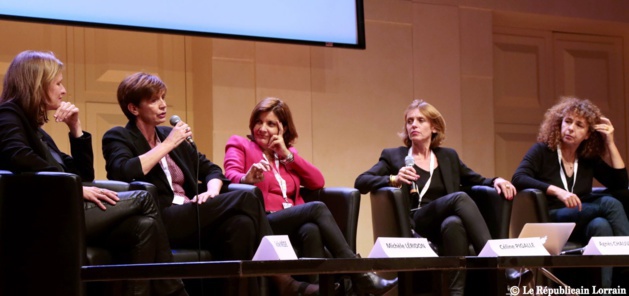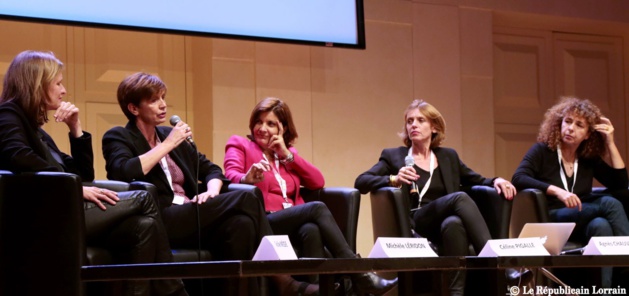
Credit Le Républicain Lorrain
The Fourth World Conference on Women took place in 1995, whose goals were to increase the participation and access of women to training, and the taking of political positions with the support of the media, as well as promoting a fair and stereotype-free image of women within it. Since then, professional gender inequalities and stereotypical media representations of women still remain.
Women in the media: a slow and late emergence
First, it is worth remembering that until the second half of the 20th century, political, economic and cultural powers were exclusively restricted to men, women being limited to the domestic and private sphere. In terms of media, men kept the public sphere for themselves, including journalistic speech.
The first female journalists did not show up in the media and public spheres until the 19th century. Their presence in the newspapers contributed greatly to the feminine condition coming into the media spotlight. Women accomplished this by taking part in the journalistic speech, to the point where they represented almost the majority of media staff.
However, producing information and taking part in broadcasting news is not enough to make yourself visible. Indeed, having a journalistic voice is not what has granted women a public and social legitimacy.
Under-represented women in newsrooms
More than 40 years ago, numerous movements came about in order to fight for gender equality in social, economic and legal rights: notably, the French Women's Liberation Movement. These movements pointed the finger at the social and professional inequalities between men and women.
Since then, women still are very rarely in positions of authority, facing the glass ceiling in all fields, including the journalistic world. Thesis not without consequences. In fact, it makes it hard for female journalists to access the media and public speech, limiting them in climbing the hierarchical ladder, therefore impeding the development of feminine role models.
On the media front, women are definitely more numerous in newsrooms, but they do not have a strong presence within the articles, whether it be sections, coverages, or portraits. The Women's Media Center highlights this trend toward sexual differentiation, showing that in 2012, in the ten main American media outlets, men accounted for 63% of bylined articles, compared to 37% for women.
This monopoly of journalistic speech can also be found in Europe. A study carried out by the Italian research institute CESI noted that only three women are executive directors, among a total of 119 Italian media outlets. In Italian television, 53% of the women employed do not appear on screen. They are also stuck with topics considered as feminine such as fashion, beauty and shows. Only 2% of the female employees manage to reach the much-coveted spheres of activity such as political, economic and social topics. Thus, the media spreads the image that men exclusively possess the voice, the language and the social recognition to be able to find their place in the public sphere.
In order to remedy this lack of visibility female journalists have, Barack Obama underlined their importance by only accepting questions from women during his last press conference of 2014.
Studies have shown that topics related to education, family and fashion are often treated by female journalists, whereas politics, international news, science, financial topics, sport and editorials are mainly entrusted to male reporters.
Women, or the invisible majority in the media
By under-representing women in the information, the traditional media used to and still makes the readers believe women assume a minor role in the public sphere. Studies have proved that women are close to absent from the media and public sphere, no matter what the topics are. Men are mentioned in press articles far more often.
According to a 2006 study of The World Association for Christian Communication, women are mentioned in 20% of global information. Another study carried out by The Status of Women in the US media in 2013 showed that, in 2012, men were quoted more than women in written press (69,4% of quotes from male speakers), television (77%), and on public radio stations (69,4%). Although women represent half of the global population, the news does not seem to need them, and men's point of view tends to become the general opinion.
Persisting stereotypes
Journalistic speech does not stay the same for men and women when they are being interview or presented. On the red carpet, female actors and directors are asked about their outfit and family, whereas their male counterparts talk about their career. To point out the stereotypes in Hollywood, the website Buzzfeed tried to ask the questions usually targeting female celebrities to the actor Kevin Spacey (House of Cards).
Sexist questions also exist in the domain of politics, as shown by Laurent Fabius’ question to Ségolène Royal during her election campaign in 2008, “But who will look after the kids?” The media present women as aid and support for men, which submit them to a gender hierarchy. For example, the German chancellor Angela Merkel's nickname is “Mutti”, which means “mother”, a nickname bringing her back to the traditional social role of women. In Italy, Silvio Berlusconi is called “il cavaliere”, a reminder of his masculinity. By spreading stereotypical images and limiting women to “feminine” jobs in newsrooms, the press plays a major role in the perpetuation of social and gender inequalities.
Finally, the media speech not only favours the construction of a public opinion to which a real social identity can be associated. It legitimizes and shapes this identity and therefore classifies people by their gender. Yet, the journalistic rhetoric adopted as the standard for informational content by society, greatly influences the other public and private spheres. Just like the political body, the media can help women confirm or not their identity as they speak, and therefore gain a stronger presence in the media and in society.
Social networks support social advances to restore equality

Credit lolaveclesconnes.tumblr.com
Many websites were created in France in order to point out sexism in speeches and the lack of presence for women. Among them, one can find Macholand, the group Prenons La Une, but also the playful Tumblr “Lolaveclesconnes”. It is about analyzing the media condemning how differently women and men are treated. They focus on these traditional and sexist representations in order to show the environment of sexism that remains in the newsrooms. Following the same idea, a Canadian website lists all the sexist insults that were thrown at the female Premiers of Ontario, British Columbia, Alberta, Newfoundland and Labrador, and previously Québec. This website sees itself as a reflection of sexism still present in politics. On social networks, the hashtag #AskHerMore made a buzz in the American news, claiming itself to be a means of exposing everyday stereotypes in journalistic interviews, and to bring journalists to ask women about more than their looks and their family.
On the international level, the hashtag #HeForShe was talked about a lot. As part of the United Nations Organization UNWomen's campaign, it sought to raise awareness of the feminist cause among men, and to give a new definition to this movement, misunderstoodby the new generations.





























